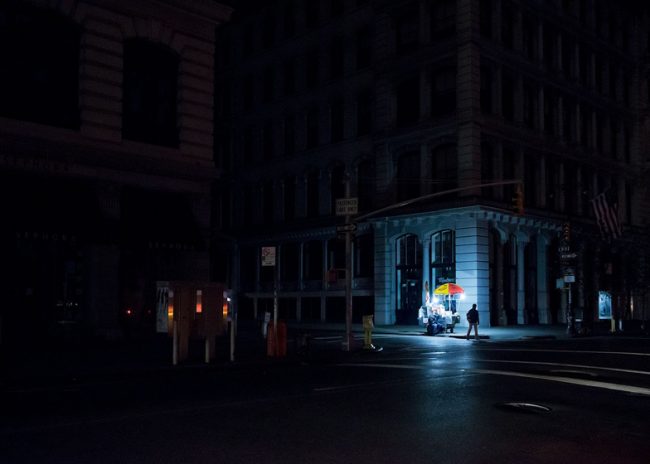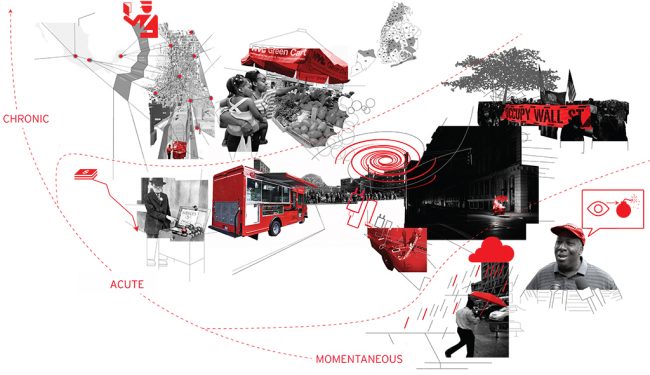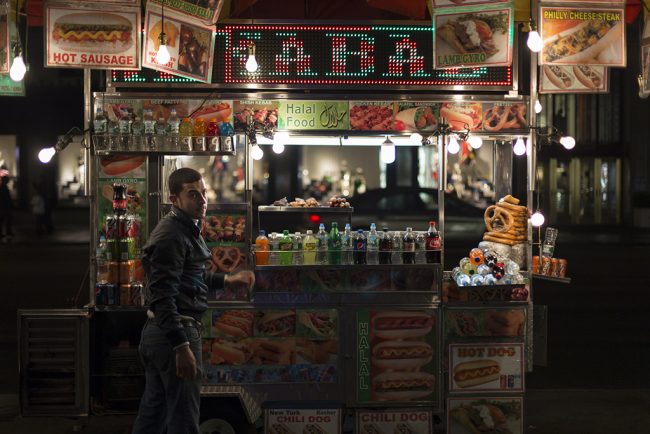
We are celebrating 15 years — and counting — of stories that are deeply researched and deeply felt, that build a historical record of what the city has been.
We are celebrating 15 years — and counting — of stories that are deeply researched and deeply felt, that build a historical record of what the city has been.

A vendor in the dark of Lower Manhattan in the aftermath of Hurricane Sandy | Photo courtesy of Iwan Baan
For more than 200 years, street vendors have been an integral part of New York City. Department store giants Macy’s and Bloomingdale’s, after all, started as collectives of door-to-door salespeople. And even more so than those institutions, New York’s estimated 20,000 vendors — by way of their highly visible sidewalk sale of food, flowers, art, books, and more — are embedded firmly in the city’s collective imaginary. When it rains in Manhattan, an umbrella is so easy to come by that a T-Mobile billboard once claimed that its network was faster than an umbrella vendor’s anticipation of rain. The public nature of vending extends to the roles vendors actively take on as direction-givers or go-to sources of change for a $10 bill.
Despite their provision of sought-after services, fellow business interests and policymakers often dismiss vendors as problematic, in part because their lack of a rent payment is considered an unfair leg-up on nearby brick and mortar shops. Regulation of the profession reflects this: vendors’ sidewalk presence is managed under convoluted rules too often used to remove them from areas where they’re deemed unwanted. Tellingly, the map of the city’s Business Improvement Districts, which are funded by local business interests, is roughly congruent with the map of streets where vending is prohibited. This bias against vending extends beyond the BIDs’ domains: across the city, vendors receive on average 40,000 tickets a year. A ticket can carry a fine of up to $1,000 for an infraction as minor as operating an inch too close to the curb or failing to display a vending license around one’s neck. Vendors are arrested roughly 10,000 times a year for reasons ranging from vending without a license to failing to comply with a police officer’s order to move, even when they are lawfully set up.
This targeting of vendors is not only unfair; it fails to recognize the broader social role vendors play in underserved communities, during massive political protests, and after accidents and natural disasters. Over the last year and a half, I’ve collaborated with the Street Vendor Project at the Urban Justice Center to look for ways to increase the capacity of street vendors to contribute to healthier and safer communities. Through interviews, workshops, stakeholder analyses, case studies, and research on portrayal of vendors on social media and blogs, I tried to understand the sociopolitical and economic context of street vending and highlight the characteristics of the industry that make vendors assets to the city.
Vending in New York is predicated on mobility and flexibility, so these enterprises often operate more informally than traditional businesses. My research focused on how these characteristics make vendors beneficial extensions to existing fixed systems when deployed during moments of crisis, broadly defined. Specific instances bear this out. During Occupy Wall Street’s stint in Zuccotti Park beginning in September 2011, vendors used their generators to supply electricity to temporary infrastructure, including the all-important media tent. Building further on the vendors’ presence, the Street Vendor Project created an online platform for supporters to purchase meals for protesters through local vendors, simultaneously supporting a movement and small businesses.

An illustration of case studies showing the social role of street vendors at different times of urban crisis. | Image by Jonathan Lapalme
After Hurricane Sandy hit in October 2012, vendors’ generators proved handy again, as did their informality and nimbleness. Food stands were the closest thing to a street lamp in the dark of Lower Manhattan. Vendors charged the phones of many New Yorkers looking for a working outlet, helping to maintain vital communication networks. Vendors traveled across the city — from Lower Manhattan to Staten Island, Red Hook, Hoboken, and the Rockaways — to serve more than 350,000 free meals. In response to this mobilization following the disaster, economist Mark Perry speculated in Bloomberg Businessweek that:
Perhaps we have inadvertently and unintentionally added a new flotilla/fleet/armada of national “emergency response” mobile food providers. It would seem that food trucks are perfectly situated to go to areas in need of food, and can get there often before the Red Cross or FEMA or the National Guard, especially in places where there is no power.
The Mayor’s Fund for the Advancement of New York City and JetBlue gave a major boost to this initiative in one of the first official recognitions of vendors’ social role in New York’s history. But after benefiting from significant media attention and satisfying the immediate post-disaster need, the sense of partnership promptly ended, and the City’s relationship with vendors returned to the status quo. Reports of excessive ticketing continued, and in the following months Mayor Bloomberg would call a proposal to reduce the outsized fines on vendors “one of the stupidest things I’ve heard.”
Vendors’ social role extends beyond the unique circumstances of Occupy Wall Street and the aftermath of natural disaster. Derrick Wilmot, a vendor for 16 years and a Vietnam veteran, notes the public service that vendors provide by having their eyes on the street at all times. He has intercepted shoplifters and intervened when children were left alone in overheating cars. He also points to Duane Jackson, the Times Square vendor who spotted the smoke that led to the discovery of a car bomb in May 2010. Jackson told the New York Times, “There are a bunch of us disabled vets selling here, and we’re used to being vigilant… All of us vets here are the eyes and ears for the cops.”
Wilmot initiated discussions with the New York City Fire Department around providing free CPR classes to vendors, resulting in a training with veteran vendors in 2014 and others with non-veterans since then. Echoing Wilmot’s vision of vendors as trained first responders, Grand Theft Auto creator Rockstar Games counseled Twitter user @tehDonkeyKong on the video game: “If you need health quickly you can go to a street vendor, a hospital or dial 911.” The game’s designers, understanding that street vendors are common throughout the city, used them as a diffuse, anticipatory, and intermediary social infrastructure for players to access health services. Could we incorporate vending services within our public health regime, perhaps even connecting it with new community outreach programs created in response to the Patient Protection and Affordable Care Act (aka Obamacare)?
Recent changes in the reimbursement framework under the Act prompt health care providers to work with community resources such as public health agencies, social service agencies, schools, and other local organizations to bolster community well-being. Street vendor coalitions could support these community outreach initiatives. Vendors trained as first responders could provide crucial information following accidents if communication channels are established. New Yorkers could sponsor free meals for those in need from vendors across the five boroughs through an online platform such as the one Street Vendor Project created in the early days of Occupy Wall Street. And like Airbnb’s ability to connect people to free shelter rooms in the wake of Sandy, this platform could quickly adapt to address changing needs in times of crisis.
The cooperation of different New Yorkers, including street vendors in the aftermath of Hurricane Sandy calls for a new emphasis on urban collaboration and symbiosis in disaster planning and city planning more broadly. Rather than offering free batteries from their Power Forward truck when the electrical grid shuts down, Duracell could partner with street vendors to distribute them, increasing their coverage area and stemming the use of short-term business tactics like price gouging. Rather than hiring an extra information guide, tourist agencies could work with vendors already performing this role in Lower Manhattan, allowing them to officially do so. Rather than deploying additional solar mobile charging stations, AT&T could invest in the social infrastructure of the city by having street vendors offer charging on the street in exchange for additional revenue.

A New York street vendor | Photo via davejdoe
Opportunities abound, especially when it comes to retrofitting street carts or food trucks to mitigate the pollution and noise that comes with their gas generators. Rather than invest in a project like Simply Grid, which provides on-demand sidewalk access to grid electricity through fixed kiosks, we could power vendors with energy sources like solar panels or biofuels that do not reduce their physical mobility or ability to remain operational when the main energy grid goes dark. Projects aspiring to this already exist: the solar-powered GrowNYC van in Union Square, Our Lady of Detritus’ “sunbrella”-powered mobile A/V system, the Solar Power Pops Truck, and the vegetable oil-fueled BLK Projek mobile green market in the South Bronx. Encouraging such programs and incubating new partnerships would not only lessen overall demand for energy and increase the amount derived from renewable sources, but street vendors acting as ambassadors for these models would increase the visibility of alternative energy sources in our most accessible and prominent public space: the sidewalk.
Because of their mobility, position on the sidewalk, and diverse demographics, street vendors are uniquely positioned to improve urban resilience. But if we are to build upon the unrecognized social role that vendors already play to help us further mitigate, adapt to, and recover from times of crisis, we must ensure that their multiple daily struggles are addressed. When vendors’ right to the sidewalk is threatened, not only are their livelihoods in danger, but the city loses out on this potential. Let’s build on infrastructure that already exists by facilitating strategic partnerships that will valorize, legitimize, and enable street vendors to work beyond their reductionist primary function and confront broader urban issues. It is time for the City to stop treating vendors as a nuisance, and to instead recognize their latent potential as rapidly deployable social infrastructure that can address existing and future needs.
For more on the rules and regulations of street vending in New York City and a description of the process to create a pamphlet to demystify them, read Candy Chang’s UO feature “Making Policy Public: Vendor Power!
The views expressed here are those of the authors only and do not reflect the position of The Architectural League of New York.